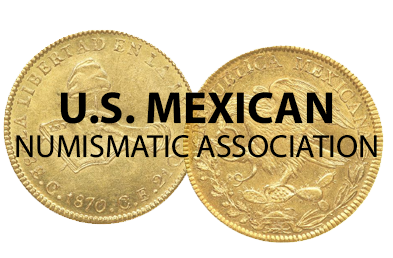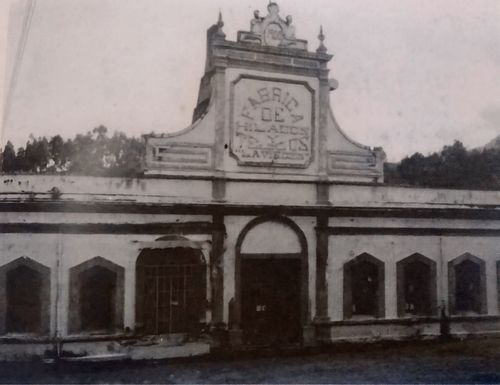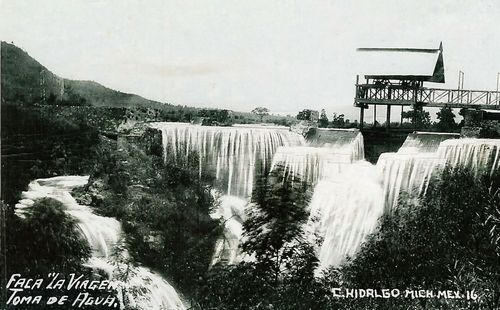La Virgen, Villa Hidalgo
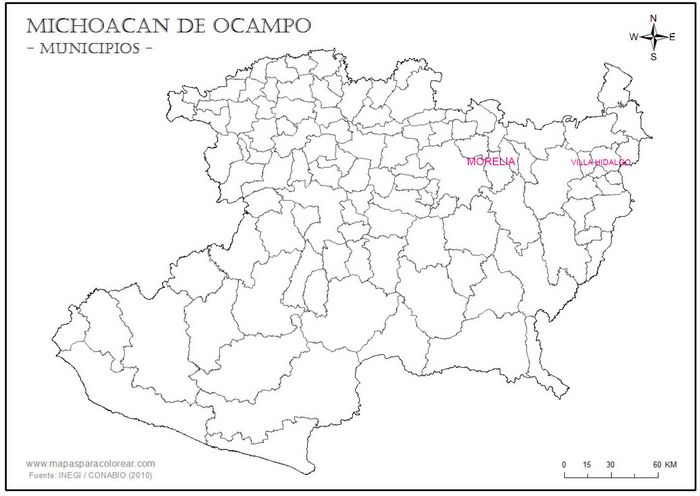
Main door of La Virgen factory
Before 1908, what is now Ciudad Hidalgo was known as Taximaroa, a name of Purépecha origin meaning “place of carpenters.” In 1908, it was renamed Villa Hidalgo in honor of the Father of the Nation, Miguel Hidalgo, and by 1921, having gained city status and serving as the head of the fiscal and judicial district, it was officially named Ciudad Hidalgo.
At the beginning of the Porfiriato, most of its inhabitants worked in timber cutting, farming, local trade, sulfur extraction from the nearby mountains of Las Humaredas and Los Azufres, and in the production of cotton and wool textiles.
On 2 January 1894, life in Taximaroa was irrevocably altered. The Governor of Michoacán, Aristeo Mercado, signed a contract with Lutero de Juanbelaz y Compañía, A. Riohaval y Compañía, Lolano Barreneche y Compañía, and B. Reves y Compañía who formed a joint-stock company, “Compañía Industrial La Virgen, S.A.”. The company’s purpose was the production and sale of cotton and linen yarn and related productsUribe Salas, José Alfredo (1983), La industria textil en Michoacán 1840-1910, Universidad Michoacana de San Nicolás Hidalgo (UMSNH).1.
Governor Mercado treated the shareholders of “La Virgen” with great favor, granting them benefits and incentives. He applied the decree from 31 May 1892 Cormina, Amador, Recopilación de leyes y decretos. Tomo XXXI, pp.129-133 that exempted companies investing over $10,000 in Michoacán state from property taxes for 15 years: then, with decree no. 45, “La Virgen” was exempted from taxes on industrial properties and establishments for 15 years, and from taxes on raw materials for ten years ibid. pp.226-228.
The initial capital allocated by the shareholders to “La Compañía Industrial La Virgen, S.A.” was $500,000 pesos. Of this amount, half was used to purchase the land, build the factory, and provide services; the remainder was used to build workers’ houses, construct a dam, and build an irrigation canal. Approximately $180,000 pesos were used to purchase machinery for spinning and weaving linen and cotton Uribe Salas, José Alfredo, op. cit.,.
In 1895, Aristeo Mercado granted this business group permission to use the waters of the Rio Grande, which flowed near Taximaroa, to build a dam and a canal to power their machinery. By 26 December 1898, the company’s success was such that they decided to increase the capital to $1,000,000 pesos, represented by 10,000 shares Ruiz Zamudio E. (2006) Burguesía empresarial, 1880-1915: un empresario mexicano el caso de Luis Barroso Arias y socios. Tesis para obtener el grado de Licenciatura en Historia, UAM.. Doubling the initial capital also increased the number of shareholders. Just for comparison, in 1902, the Banco de Michoacán had barely managed to raise $600,000 pesos in capital, while by 1898, this textile company had double its initial capital in less than four years.
La Virgen was located fourteen kilometers from the Irimbo station of the Michoacán and Pacific Railroad. Newspapers of the time described the factory facilities as modern, very much in the European style. It was built in an unpopulated area, which promised significant growth and the formation of a factory-city in the future. According to Uribe Salas, author of “The Textile Industry in Michoacán 1840-1910”, the dam that would provide the factory with power and flow so its machines could operate was inaugurated on 27 December 1895. The Governor of Michoacán himself would be responsible for opening the floodgate Other prominent figures also attended the event, including Prudenciano Dorantes, Chief Justice of the Nation, who spoke on behalf of the company’s owners. (Official Gazette, Volume IV, No. 1, Morelia, 2 January 1896)..
The first 100 workers who arrived at La Virgen were nationals, brought from Puebla, Mexico City, and Querétaro. They began producing between 250 and 260 pieces of linen a day.
A little later, the newspaper El Imparcial reported that fifteen families from Italy also arrived to work at the factory, primarily for the production of linen. In mid- August 1896, they received 80 English-made looms dedicated specifically to the manufacture of linen, an industry that was entirely new in the country Uribe Salas, José Alfredo , op. cit..
“La Virgen,” through its President and factory manager, Luis Barroso, sent the state Governor a quantity of flaxseed to distribute among the state’s landowners to attract interest in its production, knowing that the production would practically be sold out due to the high demand required by the factory to make its products. Within four years of its founding, the company already employed more than 300 workers around 150 machines. By 1899, there were more than 400 workers spread across its production departments: linen, cotton, and finished goods and clothing. By mid-1901, the company had more than 1,000 workers. In 1904 La Virgen won a Gold Medal at the World’s Columbian Exposition in St. Louis, Missouri, for the perfection of its linen products.
In 1906, La Virgen’s Board of Directors made a new capital call. The company’s share capital increased from 1,000,000 to 2,000,000 pesos, essentially doubling its total capital for the second time. This time, expansion was planned in all areas of the company, including the company’s own flaxseed planting.
La Virgen, like the railroad, seemed to be going from strength to strength, but this promising situation would not last much longer. With the outbreak of the Mexican Revolution in 1910 and the crisis that followed, production declined drastically, and hundreds of workers gradually lost their jobs. The workers at La Virgen banded together around an organization they called the “Mártires de Río Blanco,” in honor of their Veracruz colleagues who had fallen years earlier in the struggle against the exploiters. This phrase will be crucial for numismatists because, as you will see, it is part of the stamp on the notes used by this “Society of Workers” of La Virgen.
Having briefly summarized the company’s history, it remains only to move directly to the numismatic focus of this work, which is the presentation of the notes used by the Society of Workers of La Virgen. Thanks to the discovery of notes, in addition to learning about new designs and denominations, we also have the opportunity to learn at least the name of the printer and his location in the city of Villa Hidalgo, thanks to a couple of business cards found inside the cardboard box.
The printing of paper money in Villa Hidalgo
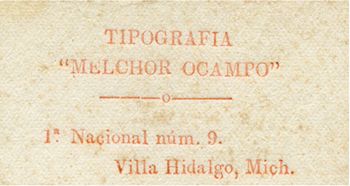
The printer responsible for the issues of “LA SOCIEDAD DE OBREROS” from the textile factory LA VIRGEN, as well as those of its sister supply distribution company, “LA UNION MERCANTIL,” and local businessmen Víctor Barajas, Lamberto Barajas, Máximo Martínez, Porfirio Peña, and E. Alanis Sucres & Co., was the “MELCHOR OCAMPO” Printing House, located at #9 of 1ª Calle Nacional, in what was then Villa Hidalgo.
Chronology of the “La Virgen” notes
The “La Virgen” notes can be subdivided into four distinct design series, beginning in September 1914 and ending in 1916. They were initially produced on paper and later changed to cardboard.
First Series
The first “La Virgen” series dates from 15 September 1914. From this previously uncataloged series, I was able to recover only 5 centavo and 20 centavo denominations in the lot discovered by Marco A. Pérez. However, based on evidence from later series, I believe that at least 10 and 50 centavo notes must have existed, although it is likely that 1 and 2 centavo banknotes were also produced, as evidenced in later issues. This first series has a floral border for security and design, which will be seen in smaller numbers in later issues from this company and as part of the design on other notes from the same printer. The 5-centavo note is on light brown paper, while the 20-centavo note was printed on “security paper” (with lines) in a light green tone.
In this first series, we can see that the header says only “LA SOCIEDAD,” with no specific reference to the workers. The two examples shown here are unnumbered and unsealed, so they should be considered surplus. To date, I have not been able to locate other examples of this series in different denominations, nor any others of the same denominations, either blank, numbered, or sealed.
It is important to note the frame design formed by a type of flower, which will be used with a similar design but in smaller quantities in later series and even on notes issued by other individuals.
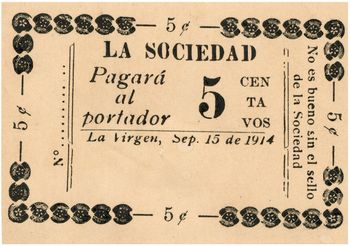 M3001 5c La Virgen
M3001 5c La Virgen
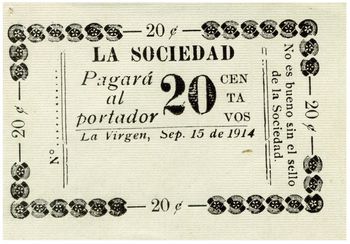 M3001.5 20c La Virgen
M3001.5 20c La Virgen
| date on note | from | to | total number |
total value |
||
| 5c | 15 September 1914 | |||||
| 10c | ||||||
| 20c | ||||||
| 50c |
Second Series
The second series also comes from Marco Antonio Pérez’s discovery, and of this series, we were fortunate to have what appears to be a complete or almost complete series, presumably missing the one-centavo note. They were printed on paper with the date 1 January 1915. The flower from the previous design is preserved, although in a smaller size, and only one was placed in each corner of the design. These examples were already numbered with a blue-green ink, a consistent characteristic of this printer, the same ink and color that can be seen on other notes, both for “La Virgen” and for other private issues.
In this series, we can again see that the upper legend, as in the previous series, only reads “LA SOCIEDAD”, with no mention of the workers.
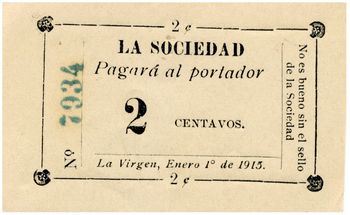 M3006.2 2c La Virgen
M3006.2 2c La Virgen
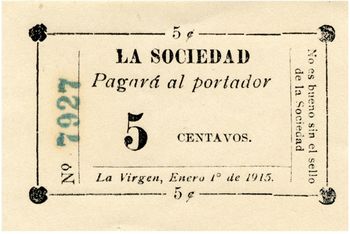 M3006.3 5c La Virgen
M3006.3 5c La Virgen
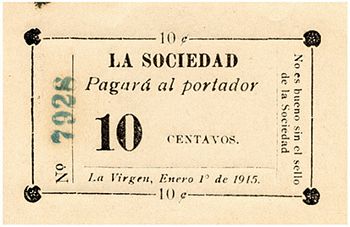 M3006.4 10c La Virgen
M3006.4 10c La Virgen
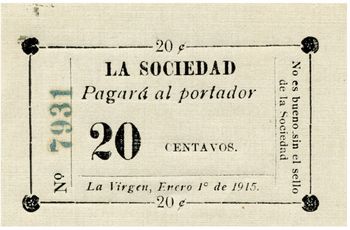 M3006.5 20c La Virgen
M3006.5 20c La Virgen
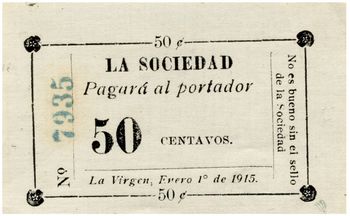 M3006.6 50c La Virgen
M3006.6 50c La Virgen
| date on note | from | to | total number |
total value |
||
| 2c | 1 January 1915 | includes number 7927 | ||||
| 5c | includes number 7934 | |||||
| 10c | includes number 7926 | |||||
| 20c | includes number 7931 | |||||
| 50c | includes number 7925 |
Third Series
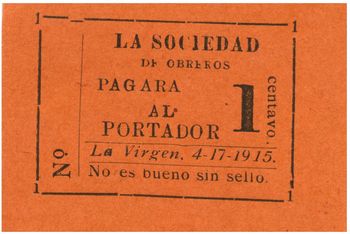 M3006.7r 1c La Virgen
M3006.7r 1c La Virgen
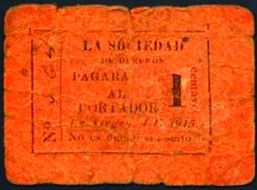 M3006.7a 1c La Virgen
M3006.7a 1c La Virgen
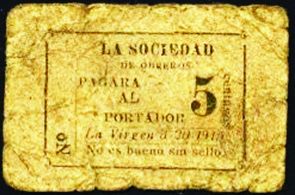 M3006.8 5c La Virgen
M3006.8 5c La Virgen
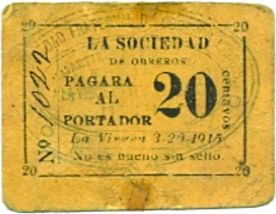
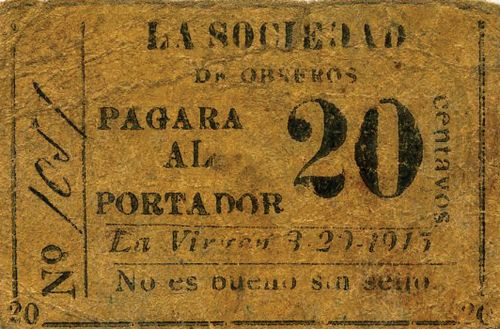 M3007 20c La Virgen
M3007 20c La Virgen
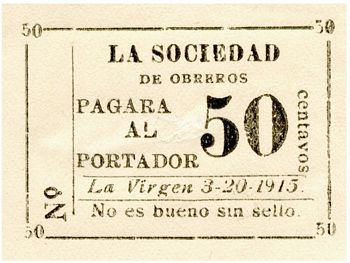 M3008b 50c La Virgen
M3008b 50c La Virgen
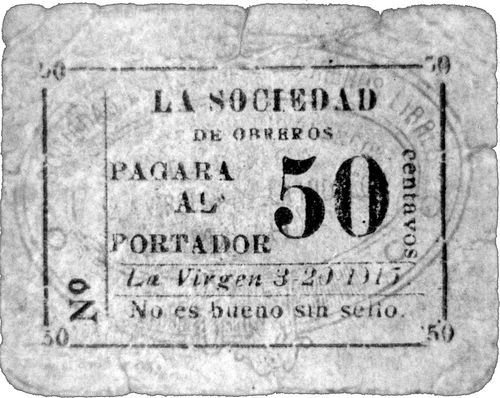 M3008a 50c La Virgen
M3008a 50c La Virgen
| date on note | from | to | total number |
total value |
||
| 1c | 17 April 1915 | includes number 564CNBanxico #5164 | ||||
| 2c | ||||||
| 5c | 20 March 1915 | includes numberCNBanxico #11567 | ||||
| 10c | ||||||
| 20c | 20 March 1915 | includes numbers 1022CNBanxico #5165 to 1297 | ||||
| 50c |
The third series was printed with two dates: 20 March for the 5, 20, and 50 centavos denominations, and 17 April 1915, for the 1 centavo notes. Unfortunately, I have not been able to locate any 2 or 10 centavo notes (which undoubtedly must have been printed), so, due to the lack of evidence, I cannot definitively state the date these denominations were printed.
Unlike the previous series, these notes now begin their legend as “LA SOCIEDAD” and just below them, in smaller type, “DE OBREROS”. In this series, the flowers from the earlier series have disappeared and have been replaced by the denomination number.
The 1 centavo notes were printed on orange cardboard. One unsealed hand- numbered example is known, which is in the Banco de México collection. Some unused 1-centavo notes were recovered from the find.
As mentioned earlier, I have not been able to locate a two-centavo note from this third series, with the five-centavo note being the next on the list. The 5-centavo note presented in this article is also from the Banco de México collection, which itself came from the Coindreau Collection. Although it is neither numbered nor sealed, it shows significant wear from use. I have not been able to locate a specimen of the 10-centavo note, which must have been printed.
The 20-centavo note is the first from the Sociedad de Obreros (Workers’ Society) of this company, which is already cataloged in Mexican Paper Money. The note presented in this article is in the Banco de México collection, hand-numbered #1022, and sealed with the legend “SOCIEDAD FRATERNAL DE OBREROS LIBRES - MÁRTIRES DE RÍO BLANCO – FÁBRICA LA VIRGEN - VILLA HIDALGO MICH” . It is important to remember that the title of “Mártires de Río Blanco” was acquired by the workers of “La Virgen” in 1910, during the beginning of the Revolution.
The Banco de México has another 20-centavo note, illustrated in Mexican Paper Money, which also belonged to the Coindreau Collection. However, I preferred to illustrate the series with this one due to the quality of its seal. The last example in this series is the 50-centavo note, of which the Banco de México does not possess any example. In Mexican Paper Money, an example is illustrated in black and white, without a number, but with the same seal as the 20-centavo note.
From the discovery at Ciudad Hidalgo only a single example was recovered in extraordinary condition.
Fourth Series
For this fourth series, the printer no longer printed the date on the notes. However, thanks to a 5-centavo issue, which was also stamped with the date (1916), they can be attributed as the last series of this Society of Workers of La Virgen.
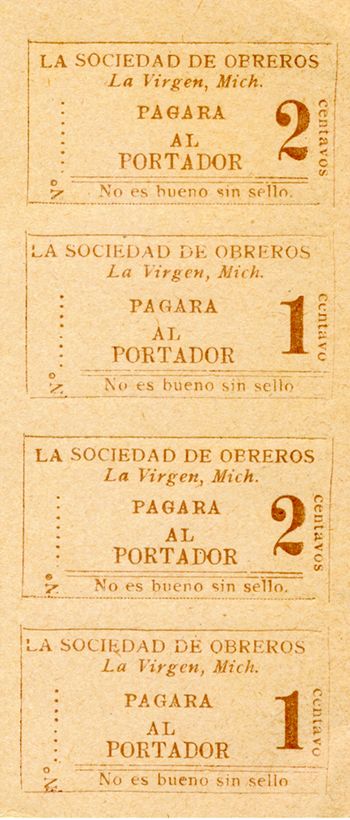 M3002b 1c & 2c La Virgen uncut sheet of four
M3002b 1c & 2c La Virgen uncut sheet of four
From Marco Pérez’s finding, although no individual notes were found, it was possible to recover at least one printing strip, from which we can see that, unlike other printers who produced banknotes with the same denomination (as in the case of the cartones printed in Zitácuaro), in this case the Melchor Ocampo Printing House issued strips of alternate denominations.
On the left, we can see the printed strip of 1 and 2 centavo notes. In this series, the initial legend reads “LA SOCIEDAD DE OBREROS,” all of it on the first line and with the same level of importance. To this day, I am not aware of any other surviving examples other than this strip without a stamp or number. Single notes can be found with stamps on both the front and back.
Of this fourth series, I have located 1, 2, 5, 10, and 20 centavos notes ; without a doubt the 50 centavo note must have been manufactured, although these are so far unknown. Overleaf are the 5, 10, and 20 centavos.
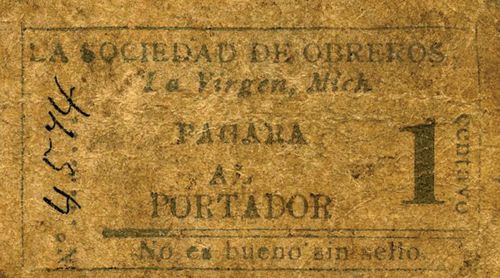 M3002a 1c La Virgen
M3002a 1c La Virgen
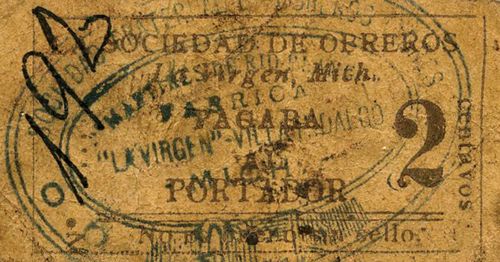
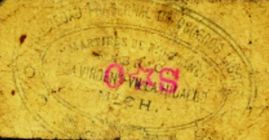 M3003a 2c La Virgen
M3003a 2c La Virgen
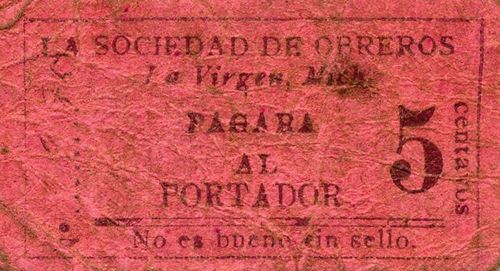
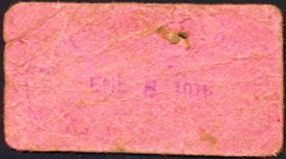 M3004 5c La Virgen
M3004 5c La Virgen
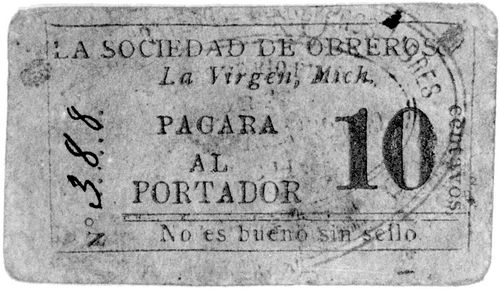 M3004 10c La Virgen
M3004 10c La Virgen
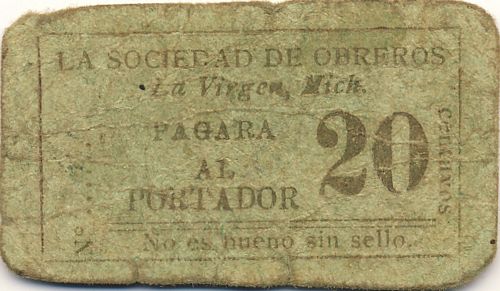
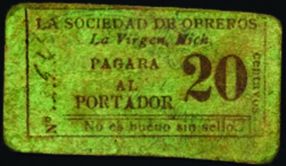
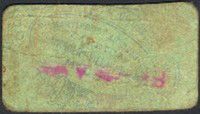 M3006 20c La Virgen
M3006 20c La Virgen
| from | to | total number |
total value |
||
| 1c | includes numbers 209CNBanxico #11565 to 4574 | ||||
| 2c | includes number 192CNBanxico #11566 to 321 | ||||
| 5c | includes numbers 208 to CNBanxico #11568 | ||||
| 10c | includes number 388 | ||||
| 20c | includes numbers 160 to 965CNBanxico #11569 |
The final series from the Sociedad de Obreros “La Virgen” is the best known, primarily because all the previously presented denominations were cataloged in Mexican Paper Money. The notes also come from important collections such as Gaytán, later Coindreau, and later Banco de México. After 1916, no other pieces from this textile factory are known, although there are some from another business owned by the shareholders of the “La Virgen” company. This was a wholesale store located in Villa Hidalgo called “La Unión Mercantil,” which was essentially a monopoly in the region and part of the “La Virgen” conglomerate.
La Unión Mercantil, La Virgen
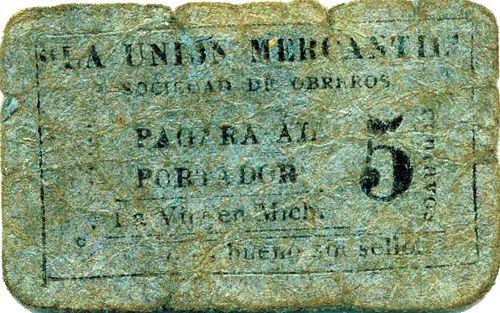 M3010a 5c La Union Mercantil
M3010a 5c La Union Mercantil
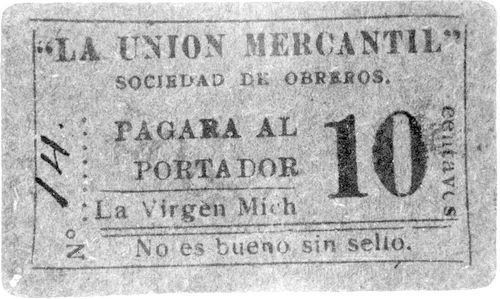 M3011r 10c La Union Mercantil
M3011r 10c La Union Mercantil
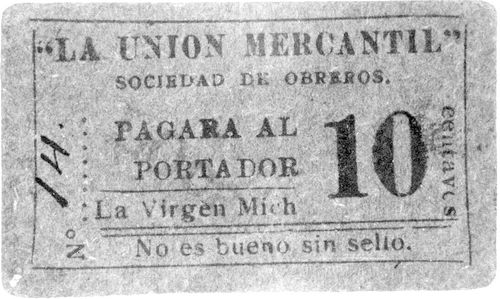 M3011a 10c La Union Mercantil
M3011a 10c La Union Mercantil
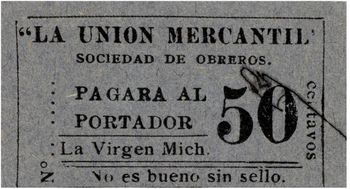 M3012 50c La Union Mercantil
M3012 50c La Union Mercantil
| from | to | total number |
total value |
||
| 5c | |||||
| 10c | includes number 14 | ||||
| 50c |
The notes from this business have a design virtually identical to that of the fourth series of “LA SOCIEDAD DE OBREROS LA VIRGEN” banknotes, except that the name changes to “LA UNION MERCANTIL” and the lettering is smaller, as in the third series of “La Virgen.” The second line reads: “SOCIEDAD DE OBREROS” (SOCIETY OF WORKERS), below which it again reads “La Virgen” Mich.
The building that housed this store at the intersection of the streets now known as Villalongín and Cuahutémoc still stands, and even its old sign is still standing.
A greenish 5-centavo note (MPM-3010) is preserved in the Banco de México Collection (#11571), with wear due to use, but without a number or stamp. This note also comes from the Coindreau Collection. In Mexican Paper Money, there is a black and white image of a 10-centavo note (M3011), which is hand-serialized with the number 14.
Thanks to the discovery of the notes I have been referring to, we also know of the existence of a gray 50-centavo note. Additionally, in this group of notes, a gray 10-centavo note (left) was recovered, as well as a print strip of three notes containing a 5-centavo note and two light green 10-centavo notes.
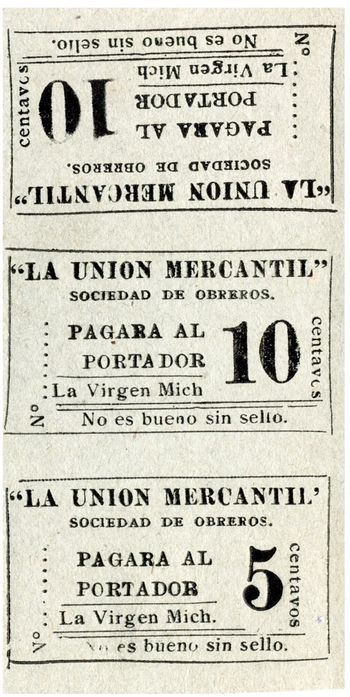 M3011b 5c & 10c La Union Mercantil uncut sheet of three
M3011b 5c & 10c La Union Mercantil uncut sheet of three
Given the evidence, it is assumed that at least the 20-centavo note that would complete the series must have been printed, and without a doubt, 1- and 2-centavo notes for this business could also be discovered.
(based on Ricardo Vargas Verduzco, Villa Hidalgo private notes: The discovery of new series from La Virgen factory in USMexNA journal September 2025)
